Welcome to our guide on enhancing your aquatic garden with the captivating beauty of baby’s tears! This versatile plant, also known as Soleirolia soleirolii, is a mat-forming perennial in the nettle family.
With its delicate and dense mat of tiny round or bean-shaped leaves on short stems, baby’s tears add a unique texture and vibrant green color to any indoor water garden.
Baby’s tears thrive in lower light conditions, making it an ideal choice for indoor gardens or spaces with limited natural light. Its moisture-loving nature and preference for rich, moist soil create the perfect environment for this aquatic plant to flourish.
Beginners will appreciate the ease with which a baby’s tears can be grown, but regular care is essential to maintain its best appearance.
Throughout this article, we’ll explore the importance of proper care and maintenance for baby’s tears plants, their characteristics, advanced care techniques for propagation, and creative ways to use them in aquatic gardens.
So, let’s dive in and discover how baby’s tears can elevate your aquatic garden experience!

Key Takeaway
- Baby’s tears, scientifically known as Soleirolia soleirolii, is a mat-forming perennial with tiny round or bean-shaped leaves on short stems.
- These plants thrive in lower light conditions and require rich, moist soil to maintain their vibrant green color and unique texture.
- Proper care and maintenance, such as watering, fertilization, and soil amendments, are crucial for the health and vitality of baby’s tears plants.
- Advanced care techniques, including propagation through division and stem cuttings, can help you expand your baby’s tears collection.
- Baby’s tears plants offer aesthetic uses as ground cover, in containers, and terrariums, adding visual interest and texture to your aquatic garden.
Quick Stats
| Attribute | Details |
| Family Name | Urticaceae |
| Origin | Mediterranean |
| Height | 3-5 cm (1-2 inches) as ground cover, with trailing stems |
| pH Range | Prefers slightly acidic to neutral soil pH |
| CO2 Requirement | Not applicable for terrestrial plants |
| Growth Rate | Fast |
| Care Level | Easy |
| Color Form | Green, with tiny, round, lush leaves |
| Water Conditions | Prefers consistently moist soil, not waterlogged |
| Max Size | Spreads indefinitely as ground cover; stems can trail up to 90 cm (35 inches) |
| Lighting | Bright, indirect light (indoor); Partial shade (outdoor) |
| Supplements | Balanced liquid fertilizer monthly during growing season |
| Placement | Excellent for terrariums, hanging baskets, and as a dense ground cover in gardens |
| Propagation | Stem cuttings or division |
What Is Baby’s Tears?
Baby’s tears (Soleirolia soleirolii) is a delicate and low-growing perennial plant native to Corsica and Sardinia, although it is now widely cultivated as an ornamental plant in many parts of the world. It belongs to the Urticaceae family.
Characterized by its tiny, round leaves and creeping habit, Baby’s tears are often used as ground cover in shady areas of gardens or as a trailing plant in hanging baskets and containers. The foliage is typically bright green and forms dense mats, making it particularly suitable for creating lush, carpet-like effects.
Baby’s tears thrive in moist, well-draining soil and prefer shaded or partially shaded locations, as direct sunlight can scorch their delicate leaves. They are relatively low-maintenance plants but require regular watering to keep the soil consistently moist.
Natural Habitat And Origin
The natural habitat and origin of Baby’s Tears, scientifically known as Soleirolia soleirolii, lie in the Mediterranean region, particularly in Corsica, Sardinia, and Italy.
This plant, also commonly referred to as Mind-Your-Own-Business or Corsican Carpet, is native to areas with moist, shaded conditions, such as damp forests, riverbanks, and rocky slopes.
Baby’s Tears typically grow as a dense mat of tiny, round leaves, creating a lush carpet-like appearance. In its natural habitat, it thrives in areas with high humidity and filtered sunlight.
This plant’s adaptability to various growing conditions has made it a popular choice for ground cover in terrariums, aquariums, and outdoor gardens worldwide.
Importance Of Proper Care And Maintenance
Proper care and maintenance are essential for the health and vitality of baby’s tear plants. They require specific attention to thrive and maintain their unique beauty.
Providing the right care ensures that your indoor aquatic plants flourish and continue to enhance your home or office space.

- Appropriate lighting: One of the key aspects of caring for baby’s tear plants is ensuring they have the right lighting conditions. These plants thrive in lower-light environments, making them suitable for indoor spaces with limited natural sunlight. Placing them near windows or using artificial lighting can help create the optimal lighting conditions for their growth.
- Adequate moisture: Adequate moisture levels are crucial for the well-being of baby’s tears plants. These moisture-loving plants should be watered regularly to prevent wilting and dehydration. It’s important to check the moisture level of the soil and water whenever it feels dry to the touch. Avoid overwatering, as it can lead to root rot and other issues.
- Proper nutrition: Proper nutrition is another vital aspect of plant care. Baby’s tears plants benefit from regular fertilization and soil amendments to maximize their growth and overall health. Using a balanced liquid fertilizer and incorporating organic matter into the soil can provide essential nutrients and help regulate moisture levels.
- Regular maintenance: Regular pruning and maintenance help shape and control the growth of baby’s tears plants. By removing dead or yellowing leaves and maintaining a tidy appearance, you can ensure that your plants remain visually appealing in the long term.
Characteristics Of Baby’s Tears
- Baby’s tears (Soleirolia soleirolii) is an herbaceous perennial often grown annually. Its unique growth habit forms a dense mat of small, round, or bean-shaped leaves on fleshy stems.
- The plant typically reaches a height of about 4 inches and can spread up to 36 inches wide, making it an excellent choice for ground cover in aquatic gardens. Baby’s tears thrive in partial sun-to-shade exposure and prefer rich, moist loam soil with a slightly acidic pH.
This moisture-loving plant blooms in late spring to early summer, producing delicate creamy ivory flowers that add beauty to the garden. Baby’s tears are hardy in USDA hardiness zones 9 to 11 and are native to the Mediterranean region.
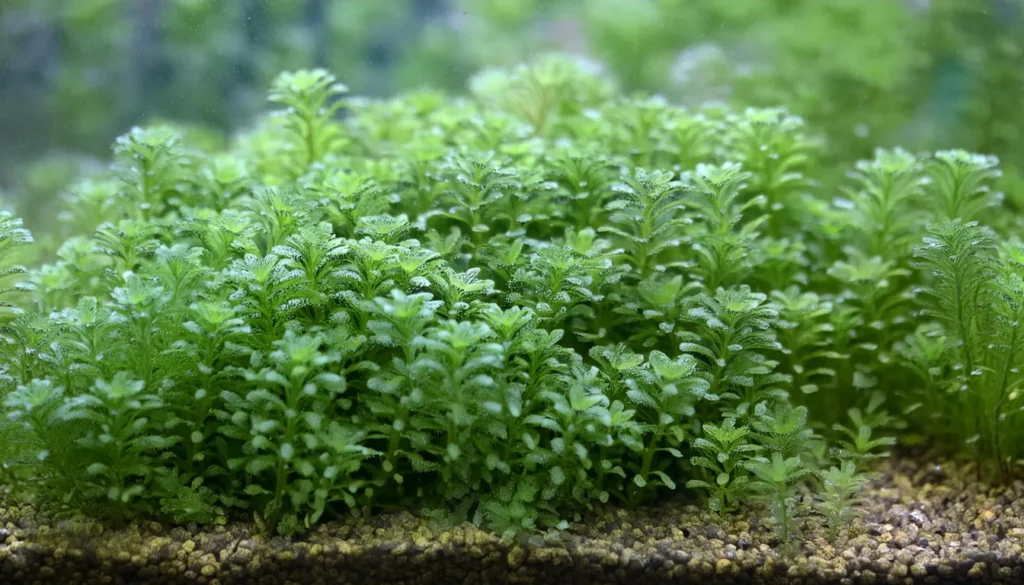
Lighting Demand For Thriving Baby’s Tears
- Bright Indirect Light: Position the plant where it can receive bright, indirect sunlight. This could be near a window with sheer curtains or in a well-lit area indoors.
- Filtered Light: If placing Baby’s Tears outdoors, ensure it receives filtered sunlight through tree canopies or lattice structures. This helps prevent direct exposure to intense sunlight, which can damage the leaves.
- Artificial Lighting: In indoor settings or where natural light is limited, provide supplemental artificial lighting. LED grow lights with adjustable intensity settings are ideal for simulating natural light conditions and promoting healthy growth.
- Consistent Lighting: Maintain consistent lighting conditions to prevent stress to the plant. Sudden changes in light intensity or duration can shock the plant and affect its growth.
Temperature Parameters For Baby’s Tears
- Indoor Temperature: Maintain indoor temperatures between 60°F to 75°F (15°C to 24°C) for Baby’s Tears. This range provides a comfortable environment for the plant to thrive without exposure to extremes in temperature.
- Outdoor Temperature: If growing Baby’s Tears outdoors, ensure temperatures remain within the range of 55°F to 75°F (13°C to 24°C). Protect the plant from frost or freezing temperatures, as prolonged exposure can damage or kill it.
- Consistency: Aim for consistent temperatures to avoid stress on the plant. Sudden fluctuations in temperature can shock Baby’s Tears and affect its growth.
- Humidity: Baby’s Tears prefer higher humidity levels, so if indoor air tends to be dry, consider increasing humidity levels through methods such as misting the plant or using a humidifier.
Water Condition For Baby’s Tears
- Moist Soil: Keep the soil consistently moist but not waterlogged. Baby’s Tears prefer soil that is evenly moist throughout, so water the plant whenever the top inch of soil feels dry to the touch.
- Well-Draining Soil: Use a well-draining potting mix to prevent water from pooling around the roots. This helps avoid root rot and other moisture-related issues.
- Avoid Standing Water: Ensure that excess water can drain freely from the pot or planting area. Baby’s Tears are susceptible to root rot if they sit in waterlogged soil for prolonged periods.
- Filtered Water: Use room temperature, filtered water when watering Baby’s Tears. Avoid using water that is too cold or contains high levels of chlorine, as it can shock or damage the plant.
- Humidity: Baby’s Tears appreciate higher humidity levels, so if the air in your home is dry, consider placing a tray of water near the plant or using a humidifier to increase moisture in the air.
Substrate Requirements
- Well-Draining: Use a substrate that allows excess water to drain freely to prevent waterlogging, which can lead to root rot. A mix of potting soil, perlite, and/or vermiculite can provide good drainage.
- Moisture Retention: Baby’s Tears thrive in consistently moist soil, so choose a substrate that retains moisture well. A blend of peat moss or coconut coir can help maintain soil moisture levels.
- pH Neutral to Slightly Acidic: Aim for a substrate with a pH level between 6.0 to 7.0, which is neutral to slightly acidic. This pH range is suitable for Baby’s Tears to absorb essential nutrients from the soil.
Choosing The Right Variety For Your Garden Aesthetic
- When selecting a variety of baby tears for your garden, consider the plants’ color and growth habits. The color should complement the overall aesthetic of your garden, whether you prefer a vibrant and bold display or a more subtle and harmonious arrangement.
- The growth habit of the plants is also important to consider, as it can affect the overall appearance and structure of your garden.
- For example, choose a variety that spreads and forms a dense mat if you want a carpet-like effect. Take your time to research and explore different varieties to find the perfect fit for your garden aesthetic.
RELATED: Grow Cryptocoryne Lutea For Vibrant Aquariums With This Simple Guide
Plant Care Essentials For Thriving Baby’s Tears
Paying attention to baby’s tear plants’ watering needs is crucial to ensuring their optimal growth. These thirsty plants should only be allowed to dry out partially.
Regular watering is necessary, and they recover quickly from wilting when watered promptly. However, it is crucial to prevent overwatering, as it can lead to root rot and other issues.
Proper drainage and well-draining soil are essential for preventing root rot while maintaining adequate moisture levels around the roots.
Monitoring the moisture levels in the soil and adjusting watering accordingly is key to prevent wilting and other common issues.
Suitable Tank Size
- Aquariums: If you’re using Baby’s Tears as a foreground or midground plant in an aquarium, a tank size of at least 10 gallons (about 38 liters) or larger is recommended. This provides enough space for the plant to spread and create a lush carpet effect.
- Terrariums or Vivariums: For terrariums or vivariums, the tank size can vary depending on the overall design and layout. Baby’s Tears can thrive in smaller enclosures, such as tabletop terrariums or larger vivariums with multiple plant species.
- Container Gardens: If you’re growing Baby’s Tears in a container garden or as a ground cover in outdoor landscaping, the tank size is less relevant. Instead, focus on providing enough space for the plant to spread and cover the desired area.
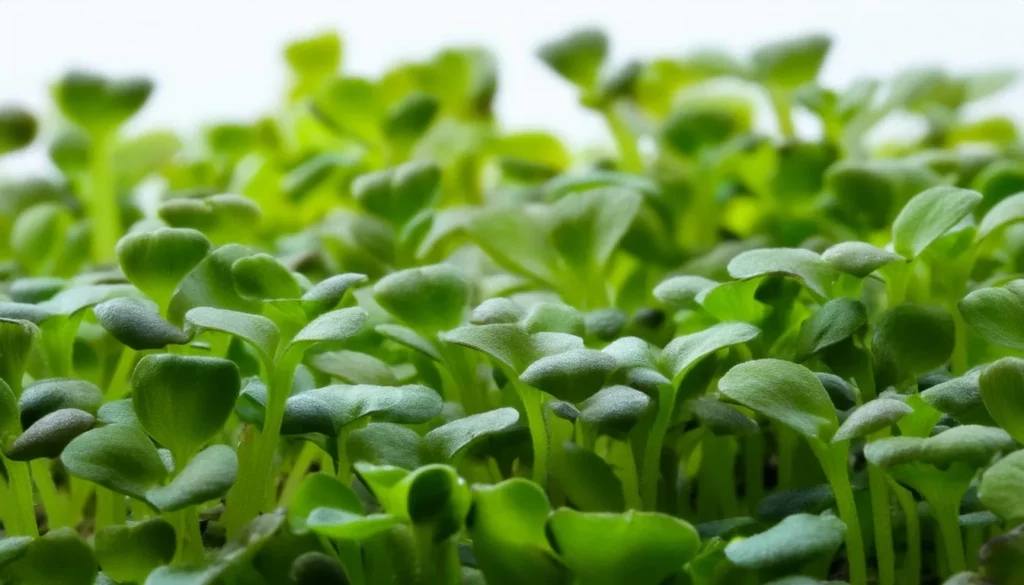
Aquatic Plant Nutrition
For optimal growth and health, Baby’s Tears (Soleirolia soleirolii) require a balanced supply of macro and micro nutrients. Here are the essential macro and micro nutrients needed for Baby’s Tears.
Macro Nutrients
- Nitrogen (N): Nitrogen is essential for the overall growth and development of plants, including the production of chlorophyll and proteins. It is a key component of fertilizers and is necessary for Baby’s Tears to maintain healthy foliage.
- Phosphorus (P): Phosphorus plays a crucial role in energy transfer within plant cells, as well as in photosynthesis, root development, and flower formation. It is vital for promoting healthy root growth in Baby’s Tears.
- Potassium (K): Potassium helps regulate water uptake, enzyme activation, and overall plant metabolism. It promotes disease resistance and enhances plant vigor in Baby’s Tears.
Micro Nutrients
- Iron (Fe): Iron is essential for chlorophyll synthesis and is involved in various metabolic processes within the plant. Baby’s Tears require iron for maintaining vibrant green foliage and overall health.
- Magnesium (Mg): Magnesium is a component of chlorophyll and is necessary for photosynthesis. It also plays a role in enzyme activation and nutrient uptake in Baby’s Tears.
- Calcium (Ca): Calcium contributes to cell wall structure, helps regulate pH levels, and promotes overall plant health. It is essential for Baby’s Tears to maintain strong and healthy foliage.
- Zinc (Zn), Copper (Cu), Manganese (Mn), Boron (B), and Molybdenum (Mo): These micronutrients are required in smaller quantities but are equally important for various physiological processes, enzyme activation, and overall plant growth in Baby’s Tears.
RELATED: Aquascaping With Anubias Barteri For A Creative Aquascape
Root Rot And Dealing With Wilting
Preventing root rot and wilting is essential for the health and longevity of baby’s tears plants. Here’s how you can prevent these common issues:
- Ensure proper drainage by using well-draining soil and pots with drainage holes.
- Avoid overwatering, as it can lead to waterlogged soil and root rot. Allow the top inch of soil to dry out before watering again.
- Monitor the plant closely for signs of wilting, such as drooping leaves. If wilting occurs, water the plant promptly.
- Avoid placing baby’s tears plants in areas with excessive heat or direct sunlight, as this can lead to wilting.
Maximizing Growth With Fertilization And Soil Amendments
- Fertilization and soil amendments are crucial for maximizing baby’s tears plants’ growth and overall health. You can ensure that your plants thrive and achieve their full potential by providing proper nutrition and optimizing soil conditions.
- To promote optimal growth, it is recommended that babies’ tears are fertilized regularly during the spring and summer months. A balanced liquid fertilizer should be applied every two weeks to supply essential nutrients and support vigorous growth.
- In addition to fertilization, incorporating organic matter into the soil can greatly benefit the plants. Materials such as humus, compost, or manure can improve soil fertility, enhance nutrient availability, and help regulate moisture levels. This is particularly important for baby’s tears plants, as they have high moisture requirements for healthy development.
- When planting baby’s tears as a houseplant or in containers, it is advisable to use commercial potting soil. This soil type provides adequate nutrition and proper drainage, essential for maintaining optimal plant health and growth.
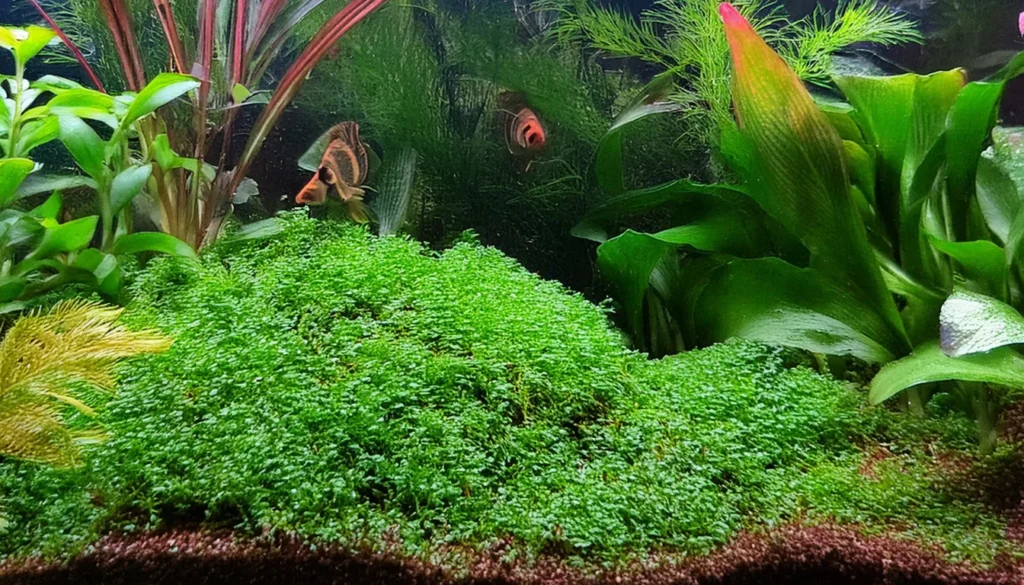
Utilizing Baby’s Tears As Ground Cover
- Baby’s tears plants offer numerous aesthetic uses in aquatic gardens due to their unique texture and vibrant green color.
- One popular application is using baby’s tears as ground cover, which creates a lush carpet-like appearance that enhances the overall aesthetic of the garden.
- The dense mat of tiny round or bean-shaped leaves creates a visually appealing green backdrop, providing visual interest and a touch of natural beauty.
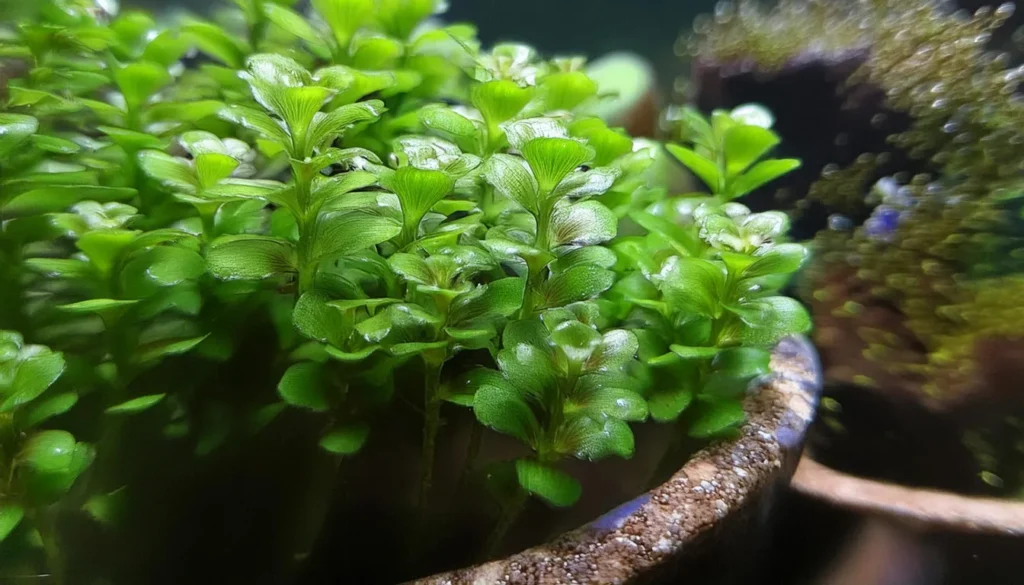
Division And Stem Cutting Techniques
Division involves separating a section of stems with roots from an existing plant and replanting it in new potting soil. To propagate the baby’s tears through division, follow these steps:
- Gently lift the baby’s tears plant from its container.
- Divide the plant into smaller sections, ensuring that each section has sufficient stems and roots.
- Replant each divided section in a new pot filled with moist, well-draining potting soil.
- Water the newly divided plants thoroughly and place them in a suitable location with the right light conditions.
Stem cuttings are another effective method for propagating a baby’s tears. Here’s how you can propagate baby’s tears through stem cuttings:
- Select a healthy stem from the parent plant.
- Remove the lower leaves, leaving only a few near the top of the cutting.
- Dip the cut end of the stem in the rooting hormone to promote root development.
- Plant the cutting in a pot filled with moist potting medium.
- Place the pot in a warm, well-lit area, but avoid direct sunlight.
- Keep the potting medium consistently moist to encourage root growth.
- Once roots have formed, transfer the cutting to a larger pot or into your aquatic garden.
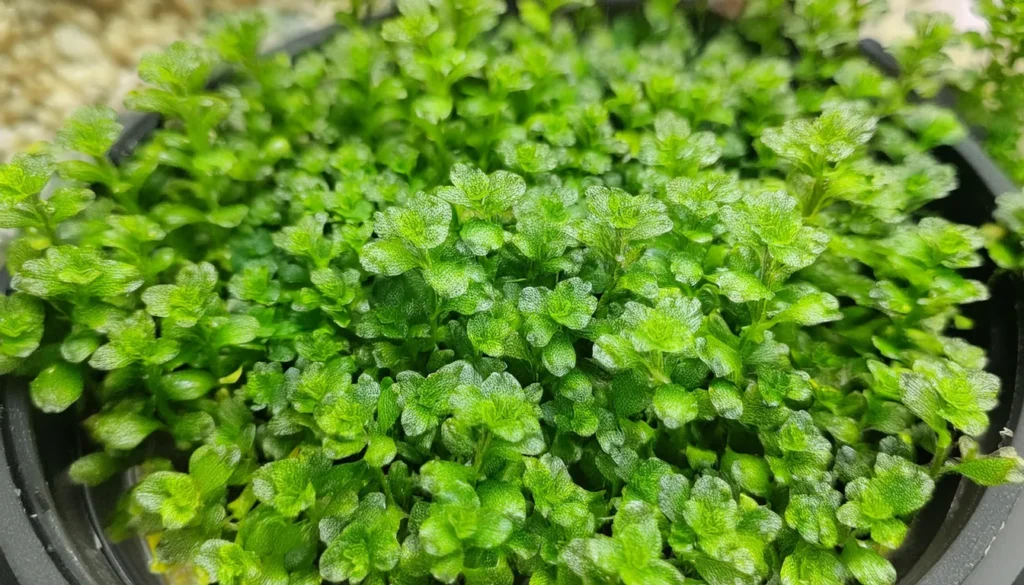
Maintenance And Pruning Tips
Proper maintenance and pruning are essential for shaping and controlling the growth of your baby’s tear plants. While pruning is unnecessary for the plant’s survival, it significantly improves its appearance by encouraging new growth and preventing overcrowding. This section provides valuable tips and techniques to help you maintain your baby’s tears plants’ health, shape, and overall attractiveness.
Regular Maintenance
- Maintaining the health of your baby’s tear plants involves a few essential tasks. Regularly inspect the plant and remove any dead or yellowing leaves.
- These leaves detract from the plant’s appearance and can indicate underlying health issues.
- By promptly removing them, you promote the plant’s overall health and maintain its vibrant green appearance.
Pruning Tips
- Pruning is particularly important when growing a baby’s tears as a companion plant or in small terrariums. It helps control the plant’s size and prevent it from overshadowing other plants or outgrowing its confined space.
- When pruning the baby’s tears, focus on removing excessive growth, particularly from the edges that may infringe on neighboring plants.
- Use clean, sharp pruning shears to avoid damaging the plant and make precise cuts just above a leaf node.

Exploring The Neighbours Of Baby’s Tears
- Low-Light Plants: Since Baby’s Tears prefer bright, indirect light, choose tank mates that thrive in similar lighting conditions. Examples include Java Moss (Taxiphyllum barbieri), Java Fern (Microsorum pteropus), and Anubias species.
- Moisture-Loving Plants: Baby’s Tears require consistently moist soil, so select tank mates that also prefer moist conditions. Plants like Dwarf Hairgrass (Eleocharis acicularis), Cryptocoryne species, and Water Wisteria (Hygrophila difformis) can complement Baby’s Tears well.
- Foreground Plants: Baby’s Tears are often used as a ground cover, so consider tank mates that complement its low-growing habit. Plants like Dwarf Sagittaria (Sagittaria subulata), Dwarf Baby Tears (Hemianthus callitrichoides), and Monte Carlo (Micranthemum ‘Monte Carlo’) can create a lush carpet effect alongside Baby’s Tears.
- Non-Aggressive Fish: If you have fish in your aquarium, choose species that are peaceful and won’t disturb or uproot the Baby’s Tears. Small, community fish like Tetras, Rasboras, Corydoras catfish, and small shrimp species like Cherry Shrimp or Ghost Shrimp can coexist peacefully with Baby’s Tears.
- Avoid High-Temperature Species: Since Baby’s Tears prefer moderate temperatures, avoid tank mates that require higher temperatures, as this could stress the plant. Instead, opt for species that thrive in the same temperature range as Baby’s Tears (around 60°F to 75°F or 15°C to 24°C).
RELATED: A Comprehensive Guide To Planting Cryptocoryne Wendtii Tropica
Conclusion
Embrace the versatility of this plants in your aquatic garden to add a unique texture and vibrant green color.
These plants thrive in various environments, whether you have an indoor water garden, containers, or a terrarium. Their cascading growth habit and ability to tolerate low light levels make them a great choice for any plant enthusiast.
Plant owners should remember the importance of proper care and maintenance for aspiring baby’s tears. Pay attention to watering techniques, ensuring the plants never dry out completely and avoiding overwatering to prevent root rot.
Regular fertilization and soil amendments will provide necessary nutrients for optimal growth, while maintenance and pruning will shape the plants and maintain their health and appearance.
Frequently Asked Questions
How Can I Ensure Optimal Growth Conditions For Dwarf Baby’s Tears To Achieve A Dense Carpet In My Aquarium?
For optimal growth, Dwarf Babys Tears require high lighting, CO2 supplementation, and a nutrient-rich substrate. High lighting encourages compact growth and helps maintain the vibrant green color. CO2 supplementation is crucial for this plant, with recommended levels around 20-30 ppm to promote faster, healthier growth. The substrate should be fine and rich in nutrients to facilitate root spread and anchor the plant securely. Regular dosing of liquid fertilizers that include micronutrients, particularly iron, supports vibrant growth and health.
What Are The Best Strategies For Planting Dwarf Baby’s Tears To Encourage Spreading And Prevent Common Issues Like Floating Away Or Rotting?
Planting Dwarf Babys Tears effectively involves separating the plant into small clumps and planting them a few centimeters apart to allow room for spreading. Use tweezers to insert each clump into the substrate deeply enough that the roots are secure but the leaves are fully exposed to light. Ensure that the substrate is moist during planting to prevent the plants from floating away. To prevent rotting, avoid burying the crown of the plant where the leaves emerge from the stem.
Can Dwarf Baby’s Tears Be Grown In A Low-Tech Tank Without Co2 Supplementation, And What Are The Implications?
Growing Dwarf Babys Tears without CO2 supplementation is challenging but possible, with the caveat that growth will be significantly slower and less compact. In a low-tech setup, focus on providing as much lighting as possible and consider using a liquid carbon supplement as an alternative to injected CO2. Be mindful that without CO2, achieving a dense carpet may be difficult, and the plant may be more susceptible to algae competition due to slower growth rates.
How Do I Effectively Manage Algae Competition With Dwarf Baby’s Tears, Considering Their Similar Requirements For Light And Nutrients?
Managing algae in tanks with Dwarf Babys Tears involves balancing light, CO2, and nutrient levels to favor the plant over algae. Limit light exposure to 6-8 hours per day and ensure CO2 and nutrient levels are sufficient to support plant growth but not so high as to encourage algae. Regular maintenance, including water changes and manually removing any visible algae, helps keep the tank clean. Introducing algae-eating fish or invertebrates can also help control algae without harming the plants.
What Advanced Propagation Techniques Can Speed Up The Carpeting Effect Of Dwarf Baby’s Tears?
For faster propagation and a denser carpet, consider the dry start method (DSM). Plant Dwarf Babys Tears in a moist substrate in a tank with no water, covering the tank to maintain high humidity. Provide high lighting and keep the substrate moist but not waterlogged. This method allows the plant to grow faster and more robustly without the challenges of underwater growth, such as algae competition. Once a dense carpet is established, the tank can be slowly filled with water, transitioning the plants to submerged growth.
- Unveiling The Wonders Of Riccia Fluitans In Aquascapes - August 7, 2024
- Vallisneria Gigantea Var. Guide To Care And Cultivation At Home - July 31, 2024
- Vesicularia Dubyana Care & Growth Guide Tips For Beginner Gardeners - July 30, 2024
